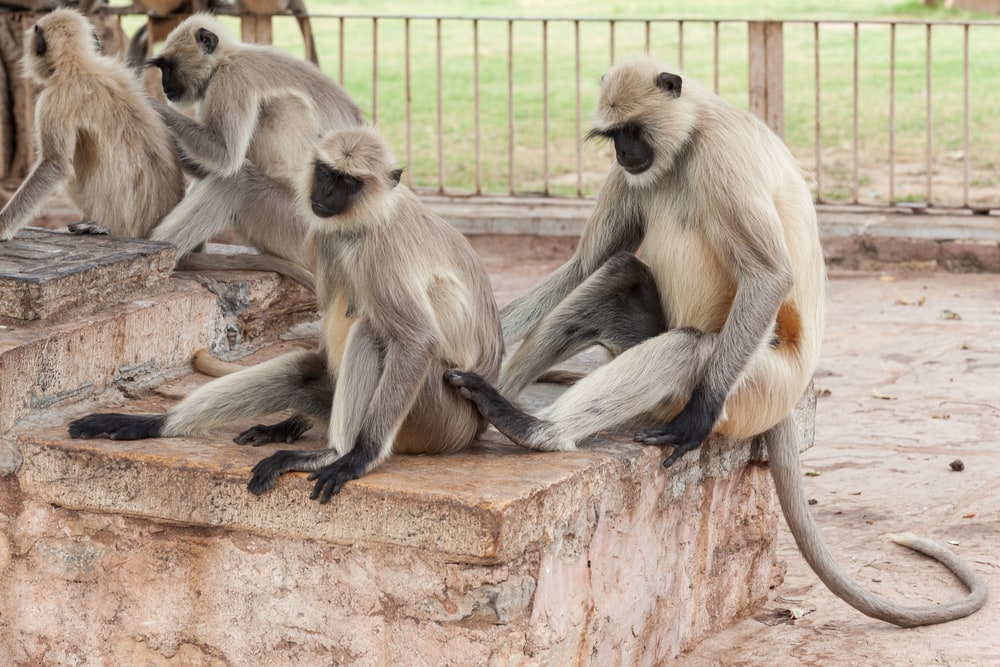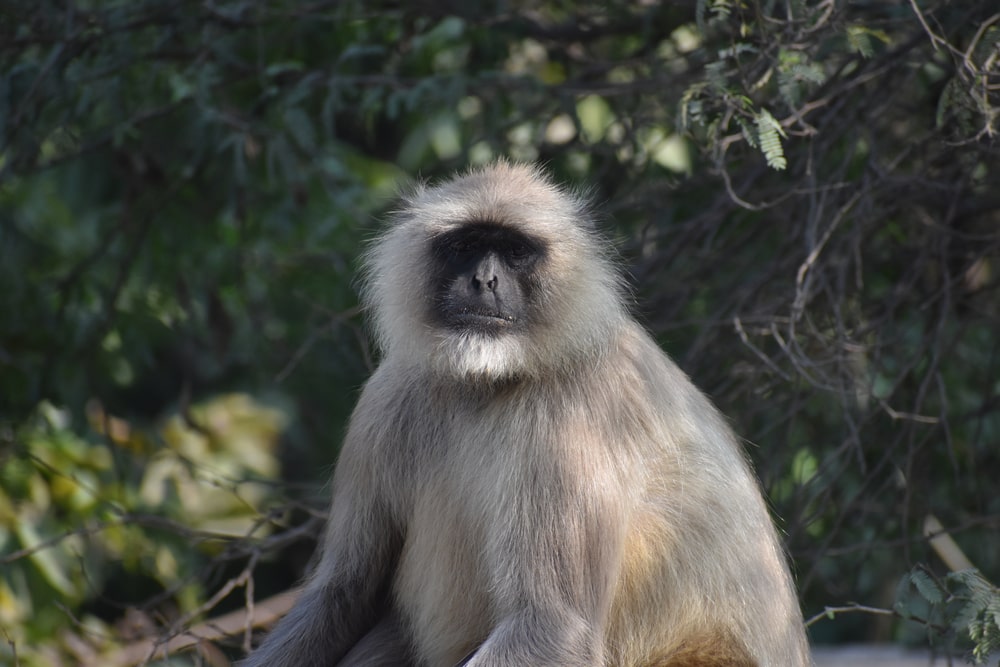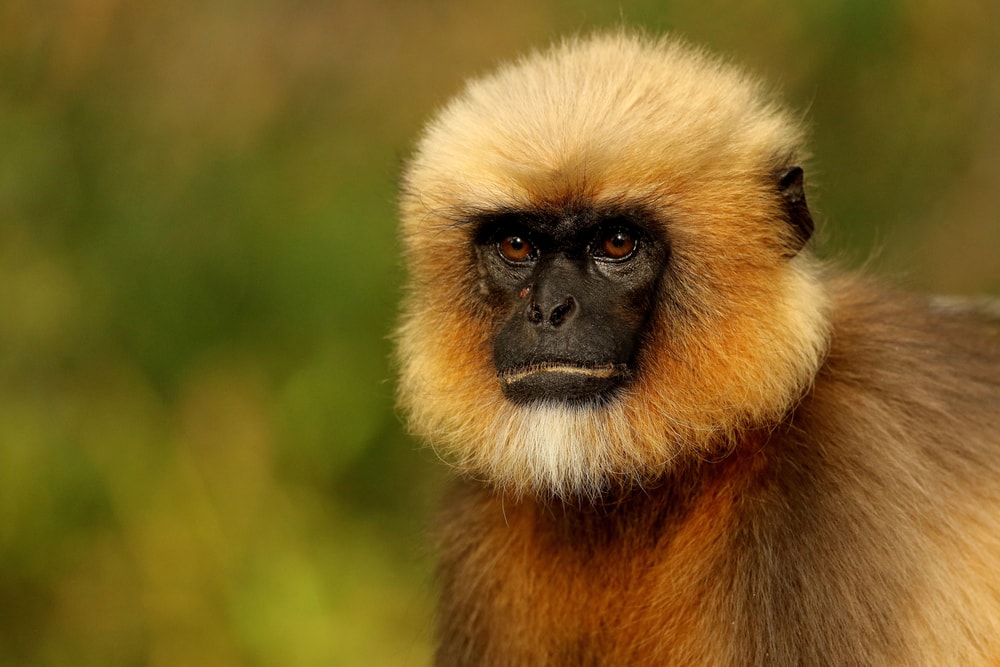Outforia Quicktake: Key Takeaways
- Northern Plains Gray Langur, also known as the Bengal sacred langur, is a species of primate found mainly in India and holds significant cultural importance.
- These langurs are characterized by their gray-brown or buff-colored fur, and adults feature a disparity in size, with males being 30% larger than females.
- In terms of habitats, they demonstrate adaptability by inhabiting a variety of climate zones and environments, including forests, lightly wooded areas, and urban environments.
- They exhibit a polygynous mating system where a dominant male typically mates with multiple females within the group.
- Despite being classified as a species of Least Concern by the IUCN Red List, these langurs still face threats including human-induced habitat loss and degradation, accidental mortality, and persecution.
The Northern Plains Gray Langur (Semnopithecus entellus) is an interesting species of primate. In India, these langurs hold a significant cultural meaning, often being referred to as sacred langurs, Bengal sacred langurs, or Hanuman langurs.
Their association with Hindu mythology, particularly the monkey-god Hanuman, grants them respect and protection in many regions of the country. Care to know why they’re so special?

Share This Image On Your Site
<a href="https://outforia.com/northern-plains-gray-langur/"><img style="width:100%;" src="https://outforia.com/wp-content/uploads/2023/10/northern-plains-gray-langur-infographics-10132023.jpg"></a><br>Northern Plains Gray Langur Infographic by <a href="https://outforia.com">Outforia</a>Appearance and Physical Description

They have a unique appearance that sets them apart from other primates.
Firstly, their size is a notable feature. Northern plains gray langurs typically have a head and body length between 410-780 mm (16.1 – 30.7 in) and a long tail, extending from 690-1,080 mm (27.2 – 42.52 in) in length. Their weights can range from 5.4 to 23.6 kg (12 to 52.0 lb).
In terms of coloration, as the name suggests, the gray langur sports gray-brown or buff-colored fur across its body. Its arms and legs are darker, with the hands and feet turning black. They also have a distinctive black face that contrasts with the lighter color of their bodies.
One striking feature of this species is the silver-gray pelage with a yellow tinge. This hue makes them stand out even more. Around their faces, they have white hair, while their backs feature darker fur.
Interestingly, their bellies have a reddish-gold color, adding another layer of visual complexity to their appearance.
You May Also Like: Exploring The Treetops: A Guide To 40 Animals That Live In Trees
Taxonomy and Morphology

The primate family these langurs belong to is known as Cercopithecidae. Within this family, they are part of the subfamily Colobinae and the genus Semnopithecus. The binomial name for this specific species is Semnopithecus entellus.
Now that you know about their taxonomy, let’s discuss their morphology.
Adults have an average combined head and body length of 25.2 inches (63.9 cm), which generally ranges from 18 to 31 inches (45 to 78.4 cm). Their long tails can add another 27 to 40 inches (69 to 102 cm) to their overall length.
Northern plains gray langurs exhibit some sexual dimorphism, which means that there are noticeable differences between males and females of this species.
Adult males are usually 30% larger than adult females. These primates are known for their gray fur, which is the reason for their name.
As a member of the suborder Haplorhini, these langurs possess certain features common to other primates in this group, like forward-facing eyes and dry noses.
Distribution and Geography

These langurs can be found in a wide range of habitats across India, south of the Himalayas.
You can spot them in forests, urban areas, Kashmir gray langur and Nepal gray langur territories, and even Bangladesh and Pakistan.
In India, these langurs thrive in various ecosystems, such as dense forests, grasslands, and even semi-arid regions.
However, their populations are most concentrated in northern India, where they inhabit forests that span from the lowland plains to the foothills of the Himalayas. The terrain in their habitats can vary considerably, and they manage to adapt to various levels of human interference.
As you move towards Bangladesh and Pakistan, you may still find these langurs, but their populations become less dense. They are predominantly found in forests and are less likely to venture into urban areas in these countries.
Living in urban areas exposes the langurs to human activity. In some places, they are revered as sacred animals and are relatively well protected.
Although their distribution spans across different countries and habitats, one thing remains consistent – their arboreal nature.
These primates are primarily tree dwellers and use their strong limbs to navigate their environment, whether it be the dense forests of India or the outskirts of bustling urban areas.
Habitat and Climate Zones

These versatile primates inhabit a variety of climate zones and habitats. You’ll find them in tropical and subtropical regions of India, south of the Himalayas.
They are primarily terrestrial, meaning they live on land, and can be found in various environments such as forests, lightly wooded areas, and urban environments.
These intelligent primates are incredibly adaptive, allowing them to thrive in both warm, lush regions and higher, cooler altitudes.
In fact, the Nepal gray langur and Kashmir gray langur are also known to reside at altitudes as high as 4,000 meters (13,000 ft) in the Himalayas.
Their adaptability not only aids their survival in different climate zones but also helps them cope with rapid environmental changes caused by human activities.
Behavior, Ecology, and Social Organization

As a diurnal species, northern plains gray langurs are most active during the day, and they spend their nights sleeping in trees to avoid predators.
During the day, they engage in various activities such as foraging for fruits, leaves, and flowers, which make up the majority of their herbivorous diet.
Socialization
A crucial aspect of their daily routine is grooming, which serves to maintain their hygiene and reinforce social bonds among group members.
The social organization of these langurs primarily revolves around a dominance hierarchy, with stronger, more assertive individuals holding higher positions. This hierarchy dictates access to resources such as food and mating opportunities.
Communication between group members is achieved through a range of vocalizations and body language, with each signal serving a specific purpose in conveying information.
Movement
When it comes to movement, northern plains gray langurs often use bipedal hops and quadrupedal walking or running. This versatility allows them to navigate efficiently on the ground and in the trees.
They are particularly skilled at leaping between branches or traversing the forest canopy, which is crucial for escaping predators and searching for food.
Seed dispersal
Within their natural habitat, these langurs play an essential role in seed dispersal, which in turn contributes to the maintenance of their ecosystem.
By consuming fruits and dispersing seeds throughout the forest, they help promote the growth of new plants and the overall health of the ecosystem.
Diet and Nutrition

Their diet consists mainly of fruits, leaves, and flowers, making them herbivores. They forage throughout the day while living in social groups, allowing them to cover more ground in search of food.
Northern plains gray langurs munch on a variety of plant species. In fact, their diet could include up to 150 different species of plants!
The types of plants they consume might vary based on the region where they live, mainly due to differences in food availability.
While fruits constitute a significant portion of the gray langur’s diet, it doesn’t limit itself to just ripe fruits. The langurs also enjoy consuming seeds, which provide them with essential nutrients for their well-being.
Don’t be surprised if they develop a taste for bark too, as it can be a valuable source of nutrition for langurs.
Contrary to some beliefs, their place in the herbivore world doesn’t mean they exclude insects entirely from their diet.
Occasionally, these langurs might come across a tasty insect while nibbling on leaves or fruit and decide to consume it. However, as insects are not a significant part of their diet, they serve as occasional supplements.
Mating Habits and Parental Care

The mating habits of northern plains gray langurs are characterized by a polygynous system wherein a dominant male langur typically mates with multiple females within the group.
When it comes to sexual maturity, both male and female langurs achieve it at different rates. Males generally become sexually mature between four to five years of age, while females become mature at around three years.
The gestation period for these langurs lasts about seven months, with only one infant born at a time. Though rare, there are instances where twins have been born.
Once the infant langurs are born, the females shoulder the responsibility of providing care. They nurture, feed, and protect their young during the crucial early stages of life.
The male langurs, however, play a secondary role in parental care, mainly focusing on group protection from potential predators.
In the case of infant langurs, the weaning process is another important aspect of their upbringing.
As these langurs are herbivorous creatures, the infants gradually switch from being solely dependent on their mother’s milk to consuming leaves, fruits, and flowers—essential components of their adult diet.
This weaning phase occurs around 12 months, marking the transition towards independence.
You May Also Like: Crossing Borders: A Look At The Lives Of 24 Animals That Migrate
Population and Conservation Status

While these langurs are mainly found in India, they have a smaller introduced population in Bangladesh.
Fortunately, the IUCN Red List classifies the northern plains gray langur as a species of Least Concern. This means that, at the moment, their population isn’t facing any immediate threats that might put them at risk of extinction.
However, it’s crucial to keep monitoring their population to ensure they maintain a stable presence in their natural habitats.
One positive aspect of their conservation status is that they are not listed in the Convention on International Trade in Endangered Species (CITES) Appendix I. This means that they are not subjected to strict regulations on international trade.
This may suggest that the demand for these primates in illegal wildlife trade isn’t as high compared to other endangered species.
Threats to the Northern Plains Gray Langur

One of the major threats to the their survival is human-induced habitat loss and degradation. Deforestation, urbanization, and agricultural expansion contribute to the destruction and fragmentation of their habitats.
As a result, these primates find it challenging to find food, shelter, and breeding grounds, which can impact their survival and reproduction rates.
Harvesting (Hunting/Gathering)
Although this species is considered sacred in the Hindu religion, it is sometimes hunted for food and other uses. This hunting pressure adds to their vulnerability and can further threaten their existence.
Accidental Mortality
Road accidents are another threat to these primates. Their habitat overlaps with human settlements, making it more likely for them to be victims of road kills. Other accidental mortalities may occur due to electrocution when langurs venture into power lines.
Persecution
In some instances, the northern plains gray langur faces persecution from humans due to crop raiding incidents or perceived threats to human safety.
Natural Disasters
Frequent forest fires can lead to severe habitat destruction, impact food availability, and pose a direct threat to the langurs’ safety. Climate change can also play a role in altering their habitat and food sources.
Changes in Native Species Dynamics
The langurs have several natural predators, such as leopards, tigers, dholes, wolves, and jackals, which can affect their populations.
Changes in population dynamics and the distribution of these predators may impact the langurs, especially when local predator populations increase.
You May Also Like: How Strong Is A Gorilla? Discover The Astounding Power Of Our Primate Cousins
Northern Plains Gray Langur Frequently Asked Questions

Can these langurs be dangerous?
While they are not known to be aggressive toward humans, they can become a nuisance in urban areas as they search for food.
How long do Gray langurs typically live?
In the wild, northern plains gray langurs can live up to 18 years. However, under captive conditions, their lifespan can extend to 30 years.
How many different species of langurs are there?
There are eight species of gray langurs, including the northern plains gray langur. They belong to the Semnopithecus genus, which comes under the Cercopithecidae family of primates.
Are there any unique traits of Northern Plains gray langurs?
They have a distinct coloration, with shades of gray, brown, or buff and lighter underparts. Their prominent brow ridge and the fur on their crown add to their distinct appearance.
How do gray langurs differ from other monkeys?
They’re Old World monkeys native to Asia and Africa. They differ from New World monkeys native to Central and South America in various ways, such as having differently shaped nostrils and lacking prehensile tails.
Gray langurs are also folivorous, meaning they primarily feed on leaves.









